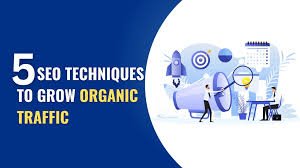Search Engine Optimization (SEO) is one of the most effective ways to increase your website’s visibility, drive more traffic, and improve your business’s online presence. If you’re a beginner and wondering where to start, this guide will walk you through the basics of SEO and show you simple steps you can take to get more website traffic quickly.
Whether you’re running a blog, an eCommerce store, or a business website, SEO can help you reach your target audience and bring in more visitors. By implementing a few fundamental techniques, you’ll see noticeable improvements in your search engine rankings and traffic flow.
1. Start with Keyword Research
Keyword research is the first step in any SEO strategy. Keywords are the words and phrases people type into search engines when looking for information. If you want your website to show up in search results, you need to understand what your audience is searching for.
Tip: Use free tools like Google Keyword Planner or Ubersuggest to find relevant keywords for your website. Focus on long-tail keywords (phrases with 3 or more words) that are less competitive and more specific to your niche. For example, instead of targeting a broad keyword like “SEO,” try “SEO tips for small businesses.”
2. Optimize Your Title Tags and Meta Descriptions
The title tag is one of the most important on-page SEO elements. It’s the clickable headline that appears in search engine results, so it needs to be compelling and contain your target keyword. The meta description, although not a ranking factor, provides a brief overview of your page and influences whether users click on your link.
Tip: Ensure that your title tags are clear, concise, and under 60 characters. Your meta description should summarize the page’s content in about 150-160 characters. Include your keyword in both to improve relevance in search results and encourage more clicks.

3. Create High-Quality Content
Search engines, especially Google, love high-quality, valuable content. To improve your rankings and drive traffic, you must focus on creating content that answers your audience’s questions and provides useful information. Content could be in the form of blog posts, how-to guides, product descriptions, or case studies.
Tip: Write informative and engaging content that provides answers or solves problems for your target audience. Aim for long-form content (1,000+ words) because longer articles tend to perform better in search rankings. Use headers, bullet points, and images to make your content easy to read.
4. Ensure Your Website is Mobile-Friendly
With more people browsing the web on their mobile devices than ever before, it’s essential to ensure that your website is mobile-friendly. Google now uses mobile-first indexing, which means it prioritizes the mobile version of your site for rankings. A website that isn’t optimized for mobile users can lead to a poor user experience, high bounce rates, and lower search rankings.
Tip: Use Google’s Mobile-Friendly Test to check if your site is mobile-optimized. Ensure your site loads quickly, navigation is easy, and all elements display correctly on smaller screens.
5. Improve Your Website Speed
Website speed is a crucial ranking factor for SEO. A slow website can harm your user experience and cause high bounce rates, which can hurt your rankings. Search engines want to provide the best experience for users, so faster sites are often ranked higher.
Tip: Use tools like Google PageSpeed Insights or GTMetrix to analyze your website’s speed. Compress images, minimize unnecessary code, and leverage browser caching to improve load times.

6. Use Internal Linking
Internal linking helps both search engines and users navigate your site more effectively. By linking to other pages within your website, you help search engines understand your site’s structure and encourage visitors to explore more of your content.
Tip: Use relevant anchor text (the clickable text) to link to other pages on your site. This can help spread link equity throughout your website and improve the rankings of other pages.
7. Optimize Your Images
Search engines can’t “see” images the way humans do, so you need to tell them what the images are about. Optimizing your images helps search engines understand your content better and can also improve your website’s performance, since large images can slow down your site.
Tip: Use descriptive, keyword-rich file names and alt text for your images. Compress large image files to improve page load speed. Tools like TinyPNG or ImageOptim can help reduce file sizes without sacrificing quality.
8. Start Building Backlinks
Backlinks are links from other websites that point to your site. They are one of the most important ranking factors in SEO. High-quality backlinks from authoritative websites can boost your rankings and drive more traffic to your site.
Tip: Start by building backlinks through guest blogging, outreach to influencers, and creating shareable content (like infographics or resource guides). Focus on acquiring links from reputable, relevant websites in your industry.
9. Use Local SEO to Target Your Audience
If you have a physical business location or serve a specific geographic area, local SEO can help you attract relevant traffic. Optimizing for local SEO ensures that your website ranks for location-based searches, such as “plumbers near me” or “restaurants in [city name].”
Tip: Claim and optimize your Google My Business profile, ensuring your NAP (Name, Address, Phone Number) information is consistent across all online platforms. Encourage satisfied customers to leave positive reviews, as they play a significant role in local search rankings.

10. Track Your Results with Google Analytics
The best way to see if your SEO efforts are working is to track your website’s performance. Google Analytics is a free tool that helps you measure key metrics like website traffic, user behavior, and conversions. By monitoring your results, you can identify what’s working and where you need to improve.
Tip: Set up goals in Google Analytics to track important actions, such as form submissions, purchases, or newsletter sign-ups. Use this data to adjust your SEO strategy and continually improve your traffic.
Conclusion
SEO for beginners might seem overwhelming at first, but by following these simple steps, you can start seeing an increase in website traffic in no time. The key is to start small, implement these foundational techniques, and be consistent. With patience and persistence, you’ll gradually climb the search rankings, attract more visitors, and grow your online presence.
By focusing on keyword research, on-page optimization, creating valuable content, and building backlinks, you can improve your site’s visibility and start seeing the results you want. Remember, SEO is a long-term game, but the payoff is worth the effort.
Related Tags:
- #SEOforBeginners
- #WebsiteTraffic
- #IncreaseTraffic
- #SEOtips
- #OnPageSEO
- #KeywordResearch
- #MobileSEO
- #Backlinks
- #LocalSEO
- #GoogleAnalytics













